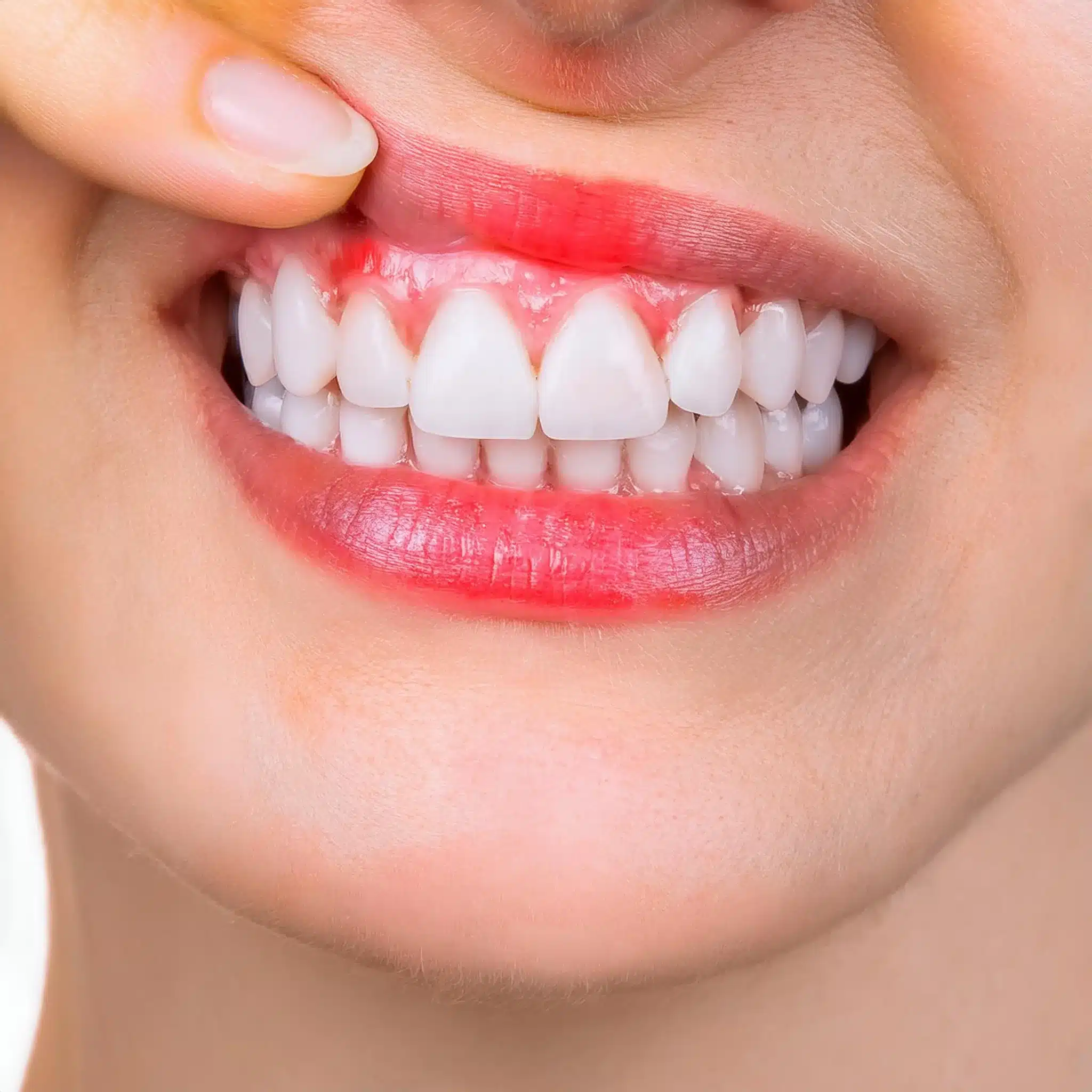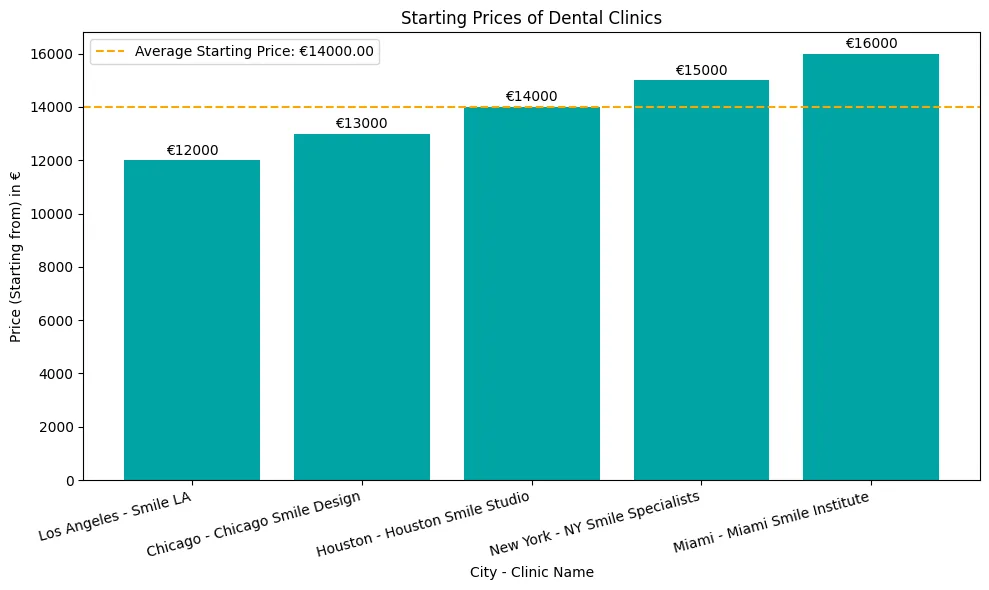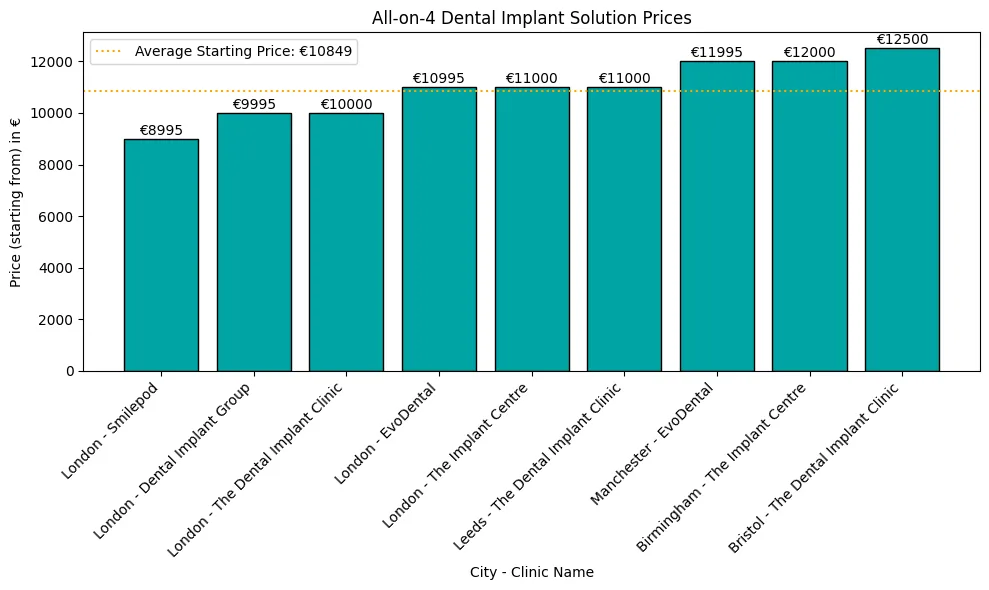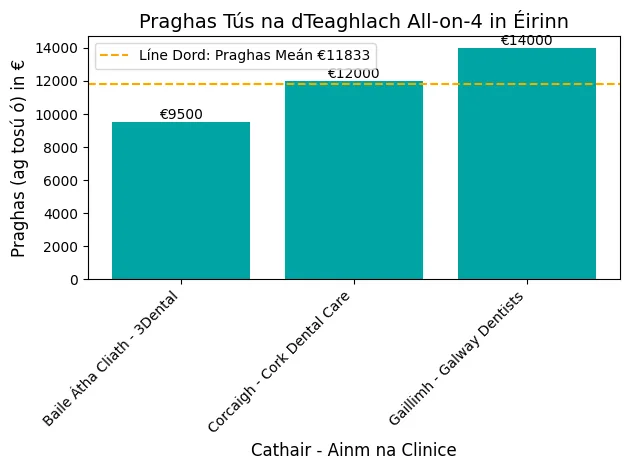Peri-implantiti, armiku i implantet dentare, është një shqetësim i madh për ata që kanë investuar në këtë procedurë që ndryshon jetën.
Nëse jeni duke përjetuar inflamacion, gjakderdhje ose dhimbje rreth implantit tuaj dentar, me siguri po pyesni se çfarë e shkakton këtë dhe si ta ndaloni atë të përkeqësohet.
Çfarë është peri-implantiti?
Peri-implantiti është një gjendje inflamatore rreth implantit dentar që shkakton humbje kockore dhe dështim të mundshëm të implantit. Shkaktohet kryesisht nga infeksionet bakteriale, higjiena e dobët orale dhe kushtet sistematike si diabeti. Diagnoza e hershme është thelbësore, me opsionet e trajtimit duke përfshirë debridimin mekanik, trajtimin antiseptik dhe, në disa raste, ndërhyrjen kirurgjikale.
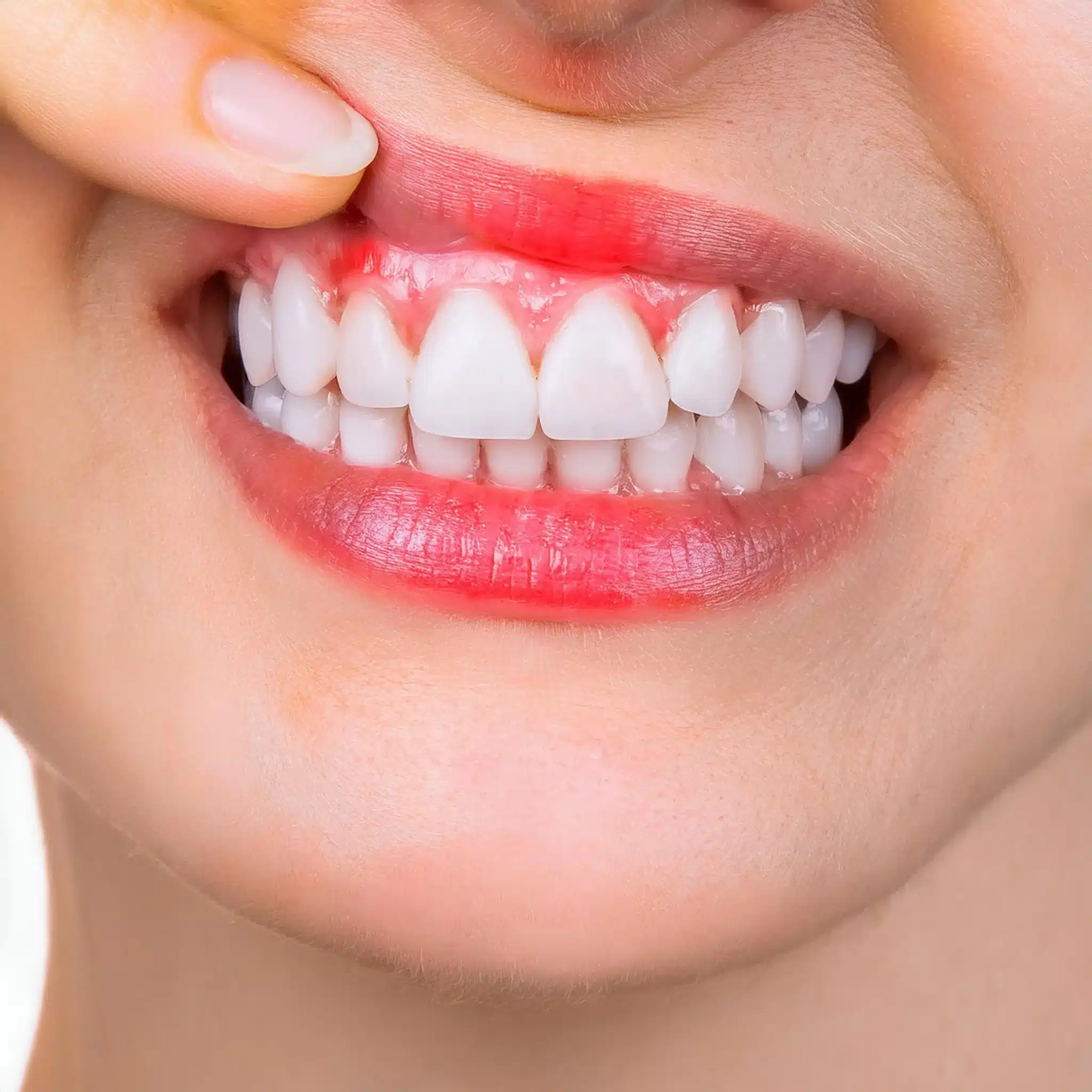
Shkaqet e peri-implantitit
Infeksion bakterial
Peri-implantiti përbën një kërcënim të rëndësishëm për jetëgjatësinë e implanteve dentare, duke çuar në potencial Dështimi dhe refuzimi i implantit dentar nëse nuk trajtohet.
Shkaku kryesor i peri-implantitit është grumbullimi i baktereve rreth implantit.
Ky infeksion shkakton inflamacion dhe humbje progresive të kockave, por gjithashtu paraqet një rëndësi të madhe rreziqet dhe komplikimet që kërcënojnë stabilitetin e implantit.
Studimet kanë treguar se biofilmat bakteriale janë çelësi për patogjenezën e peri-implantitit pasi ato shkaktojnë një përgjigje imune që rezulton në shkatërrimin e indeve (1).
Higjiena e dobët e gojës
Kujdesi i dobët oral mund të çojë në pllakë dhe infeksion dhe të rrisë rrezikun e peri-implantitit.
Higjiena e rregullt dhe e mirë orale është thelbësore për të parandaluar akumulimin bakterial dhe për të mbajtur indet rreth implantit të shëndetshëm (2).
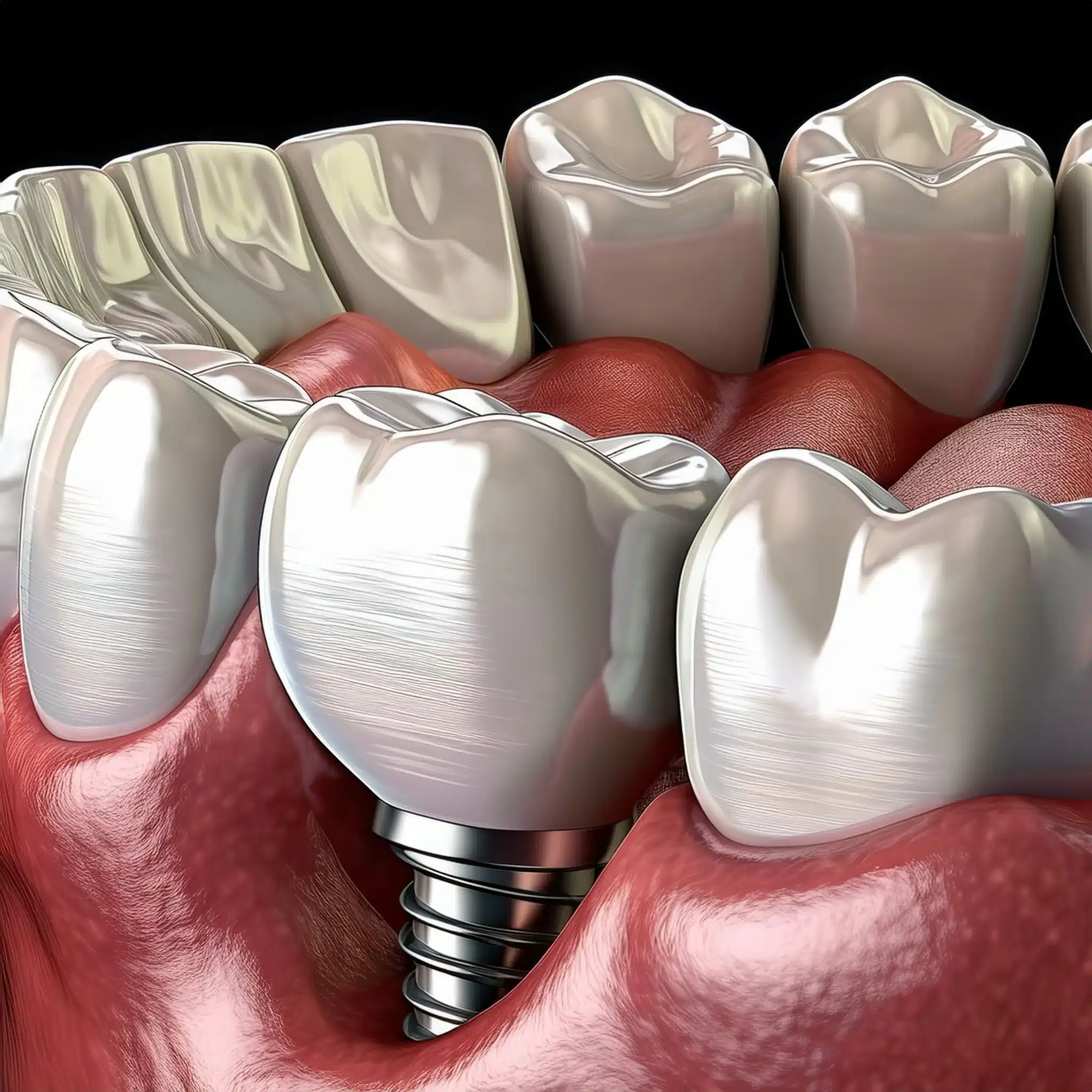
Kushtet sistemike
Kushtet sistemike si diabeti mund të rrisin rrezikun e peri-implantitit.
Këto kushte mund të dëmtojnë aftësinë e trupit për të luftuar infeksionet dhe ta bëjnë atë më të ndjeshëm ndaj inflamacionit dhe humbjes së kockave rreth implantit (3).
Pirja e duhanit
Pirja e duhanit është një faktor rreziku kryesor për peri-implantitis.
Pirja e duhanit ndikon në rrjedhën e gjakut dhe përgjigjen imune dhe mund të komprometojë shërimin dhe të rrisë rrezikun e infeksionit dhe inflamacionit rreth vendit të implantit (4).
| Faktori i rrezikut | Përshkrimi |
|---|---|
| Infeksion bakterial | Akumulimi i biofilmave bakterialë rreth implantit, duke çuar në inflamacion dhe humbje kockore(1). |
| Higjiena e dobët e gojës | Kujdesi joadekuat oral që rezulton në akumulimin e pllakës dhe rrezikun e rritur të infeksionit (2). |
| Kushtet sistemike | Kushtet si diabeti që dëmtojnë aftësinë e trupit për të luftuar infeksionet, duke rritur ndjeshmërinë ndaj peri-implantitit (3). |
| Pirja e duhanit | Përdorimi i duhanit ndikon në rrjedhën e gjakut dhe reagimin imunitar, duke kompromentuar shërimin dhe duke rritur mundësinë e infeksionit (4). |
Simptomat e peri-implantitit
Inflamacion
Peri-implantiti fillon me inflamacion, duke u shfaqur si skuqje dhe ënjtje rreth vendit të implantit.
Kjo simptomë fillestare është një përgjigje ndaj akumulimit të biofilmit bakterial dhe, nëse nuk adresohet, mund të çojë në komplikime të mëtejshme (2).
Gjakderdhje
Gjakderdhja gjatë sondës ose spontanisht është një shenjë e peri-implantitit.
Kjo do të thotë se ka inflamacion dhe infeksion në indet peri-implantare, të cilat, nëse nuk trajtohen, mund të përparojnë në kushte më të rënda (3).
Humbja e kockave
Një nga simptomat më shqetësuese të peri-implantitit është humbja progresive e strukturës mbështetëse të kockave.
Kjo humbje kockore është shpesh jolineare dhe mund të përshpejtohet nëse shkaqet themelore nuk menaxhohen mirë.
Është e rëndësishme të monitorohen rregullisht nivelet e kockave për të parandaluar dështimin e implantit (4).
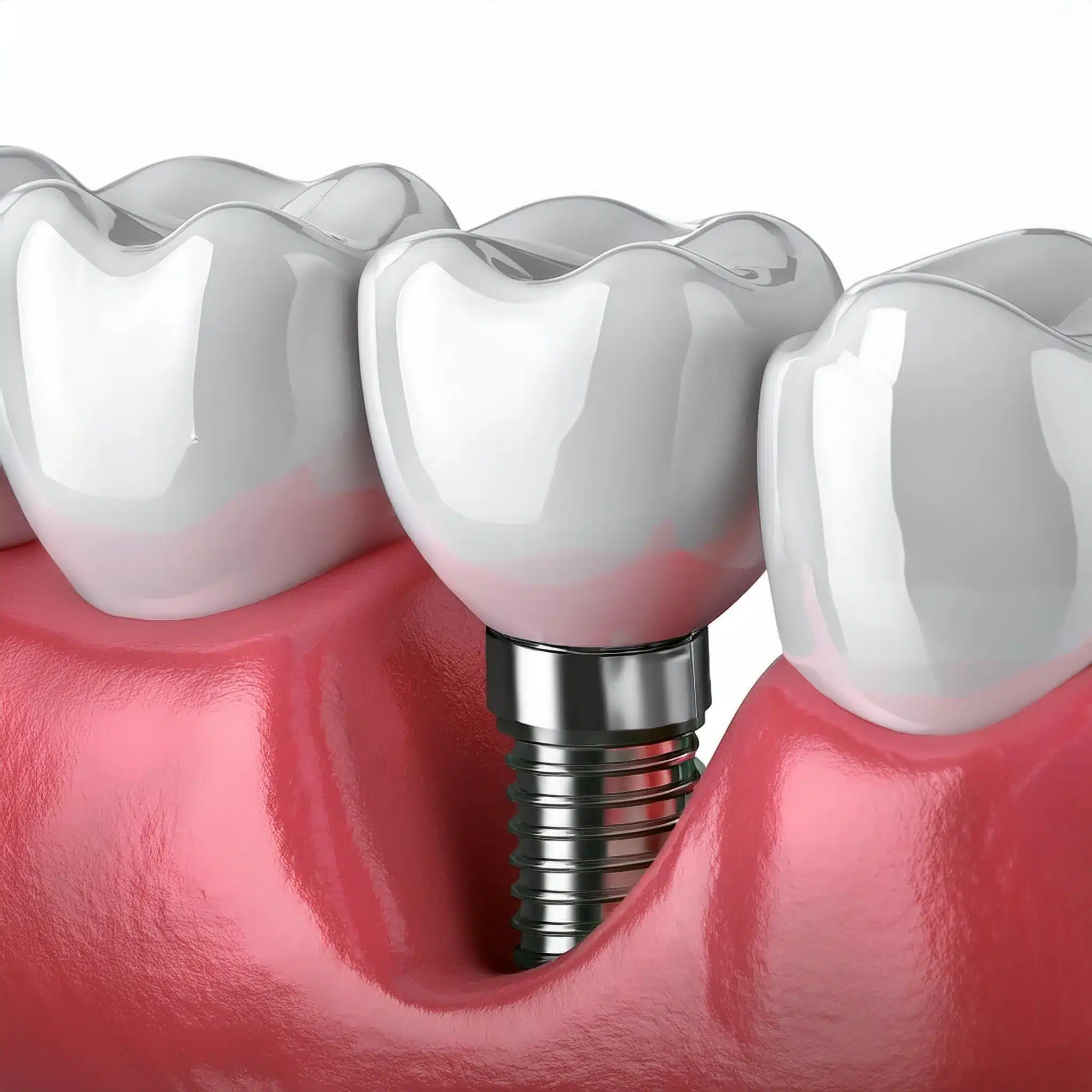
parehati
Pacientët me peri-implantitis mund të përjetojnë dhimbje ose parehati rreth vendit të implantit.
Ky shqetësim mund të jetë i lehtë në i rëndë dhe shpesh lidhet me shkallën e inflamacionit dhe humbjes së kockave.
Trajtimi i hershëm i kësaj simptome mund të ndalojë përparimin e sëmundjes (5).
Nëse i vini re këto simptoma herët dhe merrni kujdes profesional dentar, prognoza është më e mirë për pacientët me peri-implantitis.
Monitorimi dhe mirëmbajtja e rregullt janë çelësi për menaxhimin e këtyre simptomave dhe mbajtjen e implanteve dentare të shëndetshme.
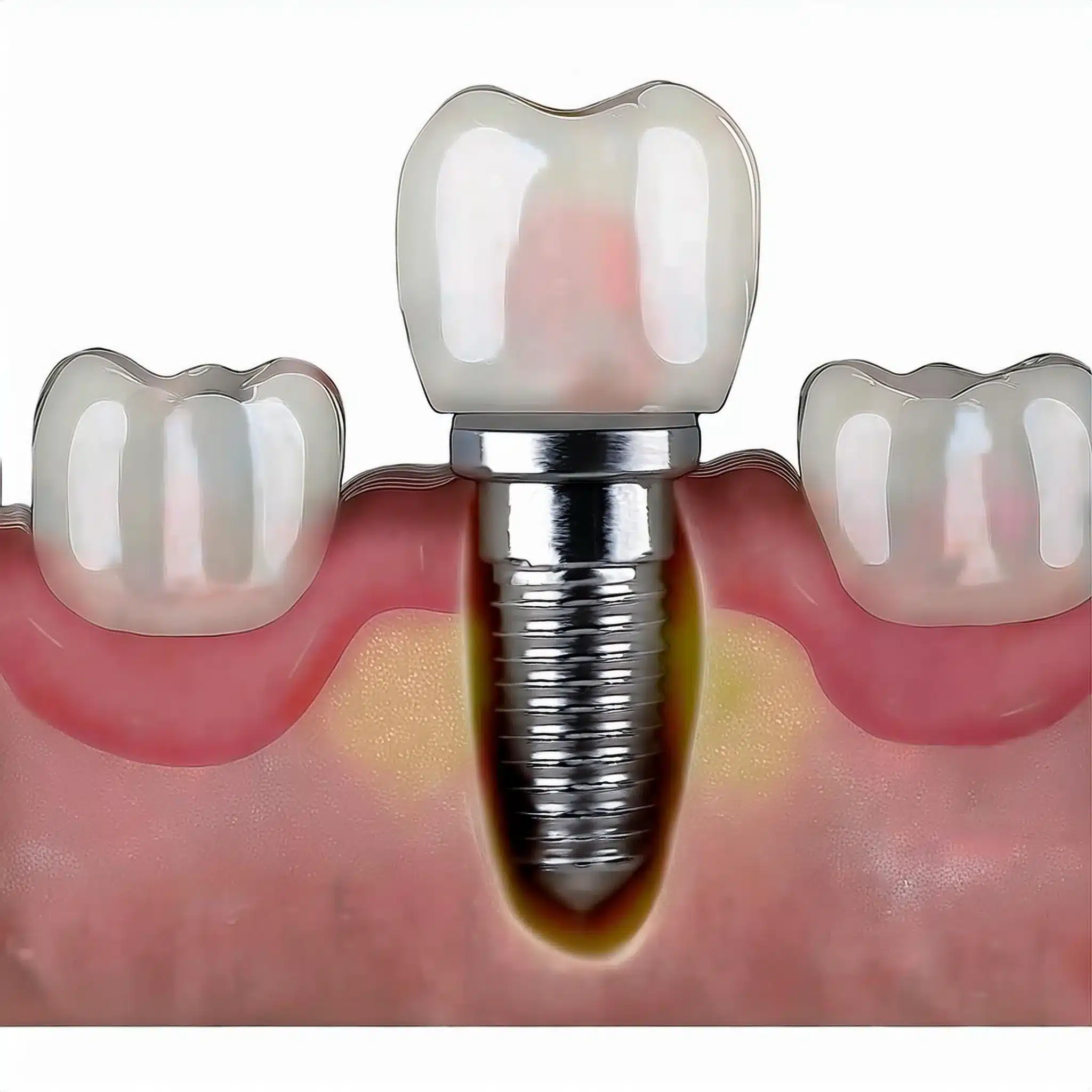
Diagnoza e Peri-implantitit
Ekzaminimi klinik
Diagnoza e peri-implantitit përfshin një ekzaminim klinik për të kërkuar shenja të inflamacionit dhe gjakderdhjes.
Kjo përfshin gjakderdhje në sondë dhe/ose suppurim, rritje të thellësisë së sondës dhe recesion të mukozës peri-implantare (3 thellësi).
Analiza radiografike
Radiografia përdoret për të vlerësuar nivelet e kockave rreth implantit.
Kjo ndihmon për të identifikuar humbjen margjinale të kockave, e cila është një shenjë e peri-implantitit.
Radiografitë e rregullta mund të monitorojnë humbjen e kockave dhe të udhëheqin trajtimin (4).
Matja e thellësisë së sondës
Matja e thellësisë së xhepave rreth implantit është e rëndësishme për diagnostikimin e peri-implantitit.
Rritja e thellësisë së kërkimit në krahasim me ekzaminimin e mëparshëm do të thotë se ka inflamacion dhe infeksion.
Kjo matje ndihmon për të përcaktuar ashpërsinë e gjendjes dhe planin e trajtimit (5).
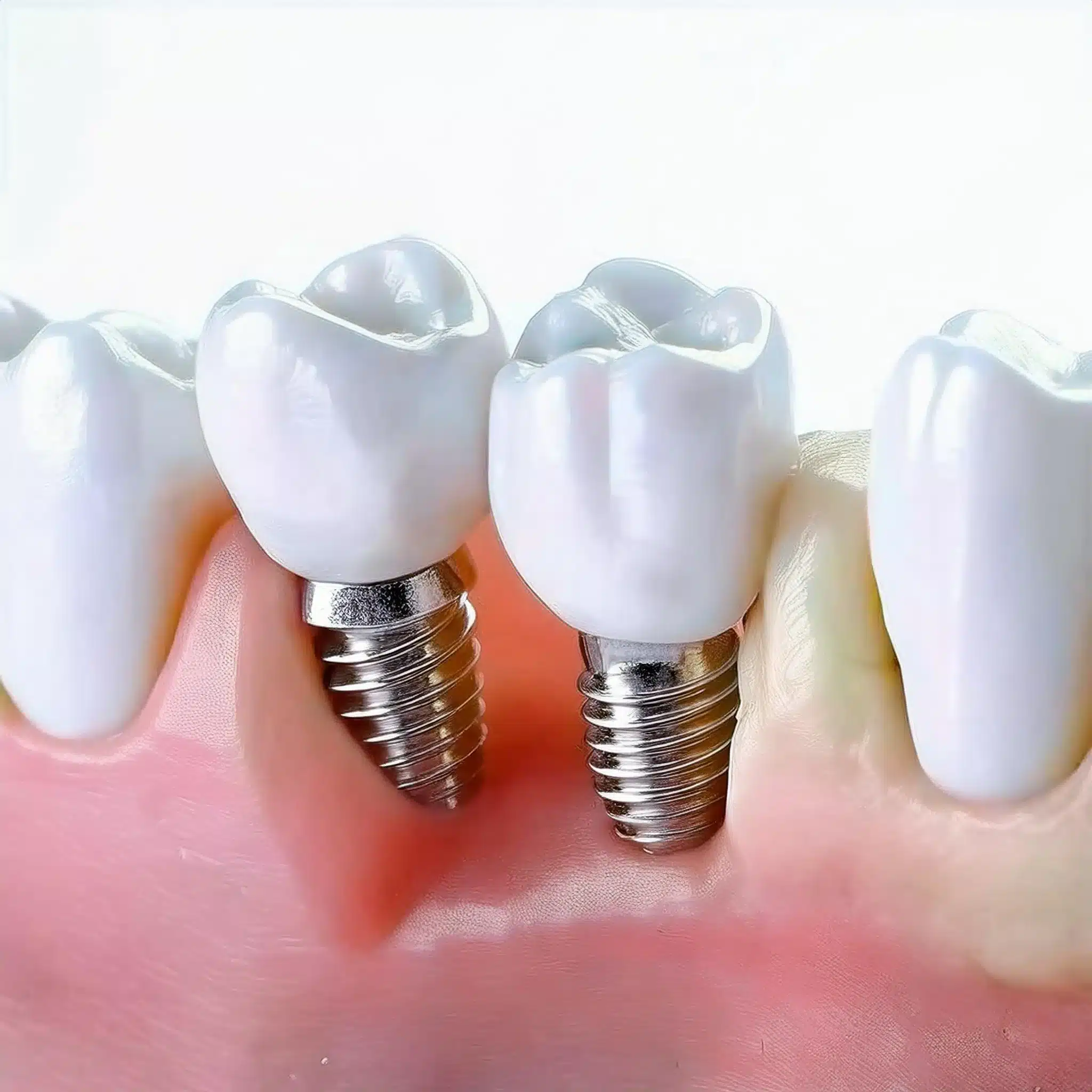
Kriteret diagnostike
Peri-implantiti mund të diagnostikohet në bazë të kritereve klinike, të cilat përfshijnë shenja peri-implantuese të inflamacionit, gjakderdhjes dhe/ose mbytjes në probimin e butë dhe thellësinë e rritur të provës.
Këto kritere ndihmojnë në diferencimin e peri-implantitit nga kushtet e tjera dhe për të ndërhyrë herët (6).
Trajtimi i Peri-implantitit
Trajtimi jokirurgjikal
Trajtimi jo-kirurgjikal i peri-implantitit përfshin debridementin mekanik dhe trajtimin antiseptik.
Këto metoda synojnë heqjen e biofilmave bakterialë dhe reduktimin e inflamacionit për të parandaluar humbjen e mëtejshme të kockave dhe për të nxitur shërimin.
Studimet kanë treguar se trajtimi jo-kirurgjikal mund të jetë efektiv në menaxhimin e peri-implantitit, veçanërisht kur kombinohet me kontrolle të rregullta dentare dhe zakone të mira të higjienës orale (2).
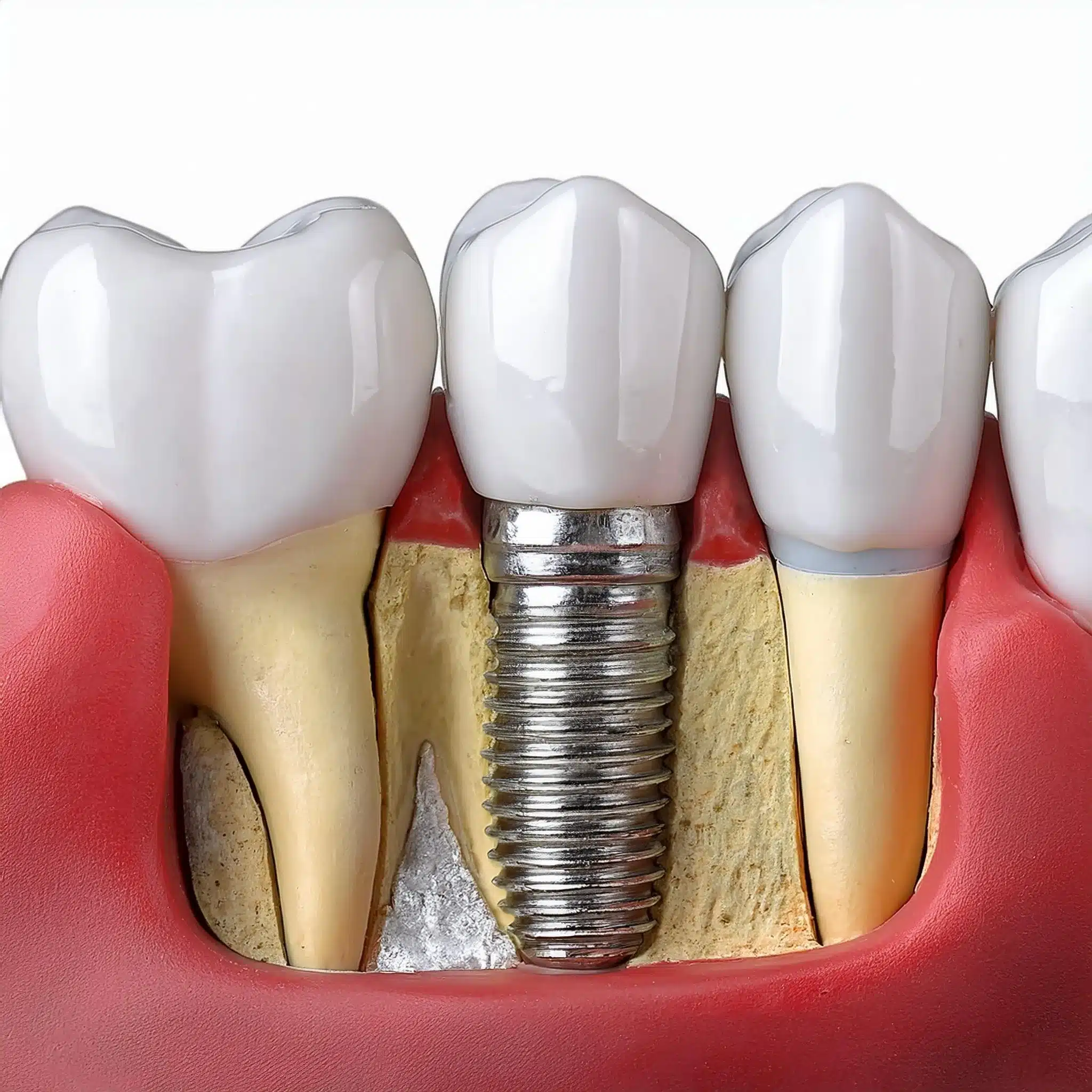
Mjekimi Kirurgjik
Trajtimi kirurgjik mund të jetë i nevojshëm për rastet më të avancuara të peri-implantitit.
Kjo përfshin operacionin e përplasjes për të pastruar dhe rigjeneruar kockën rreth implantit.
Trajtimi kirurgjik synon heqjen e indeve të infektuara, dekontaminimin e sipërfaqes së implantit dhe nxitjen e rigjenerimit të kockave.
Hulumtimet kanë treguar se trajtimi kirurgjik mund të jetë efektiv në trajtimin e peri-implantitit, veçanërisht kur kombinohet me trajtimin me antibiotikë dhe kujdesin e mirë pas operacionit (3).
Trajtimi me antibiotikë
Trajtimi me antibiotikë shpesh përdoret si një ndihmës për trajtimin e periimplantitit.
Antibiotikët sistematikë ose lokalë mund të kontrollojnë infeksionin dhe të zvogëlojnë inflamacionin.
Zgjedhja e antibiotikut varet nga ashpërsia e infeksionit dhe shëndeti i përgjithshëm i pacientit.
Hulumtimet kanë treguar se trajtimi me antibiotikë mund të jetë efektiv në menaxhimin e peri-implantitit, veçanërisht kur kombinohet me trajtim jo-kirurgjikal ose kirurgjik (4).
Trajtimi me laser
Trajtimi me lazer është një tjetër mundësi për peri-implantitin.
Laserët mund të heqin indin e infektuar dhe të nxisin shërimin.
Hulumtimet kanë treguar se trajtimi me lazer mund të zvogëlojë inflamacionin dhe të mbushë kockat në defektet e peri-implantitit (5).
| Opsioni i trajtimit | Përshkrimi |
|---|---|
| Trajtimi jokirurgjikal | Debridement mekanik dhe trajtim antiseptik për të hequr biofilmat bakterial dhe për të reduktuar inflamacionin(2). |
| Ndërhyrja kirurgjikale | Kirurgjia me flap për të pastruar dhe rigjeneruar kockën rreth implantit, shpesh e kombinuar me terapi antibiotike (3). |
| Terapia me antibiotikë | Antibiotikë sistematikë ose lokalë për të kontrolluar infeksionin dhe për të reduktuar inflamacionin, që përdoren shpesh si një trajtim shtesë (4). |
| Terapia me laser | Përdorimi i lazerëve për të hequr indet e infektuara dhe për të nxitur shërimin, efektiv në reduktimin e inflamacionit dhe promovimin e mbushjes së kockave në defektet peri-implantitis (5). |
Parandalimi i peri-implantitit
Kontrolle të rregullta dentare
Kontrollet e rregullta dentare janë çelësi për monitorimin e shëndetit të implantit dhe parandalimin e peri-implantitit.
Këto vizita mundësojnë zbulimin e hershëm të çdo shenje inflamacioni ose infeksioni dhe ndërhyjnë herët për të parandaluar komplikime të mëtejshme (1).
Higjienë e mirë orale
Zakonet e mira të larjes dhe përdorimit të fillit me fill janë të rëndësishme për të ruajtur shëndetin e indeve rreth implanteve dentare.
Praktikat e mira të higjienës orale mund të parandalojnë akumulimin bakterial dhe të zvogëlojnë rrezikun e peri-implantitit (2).
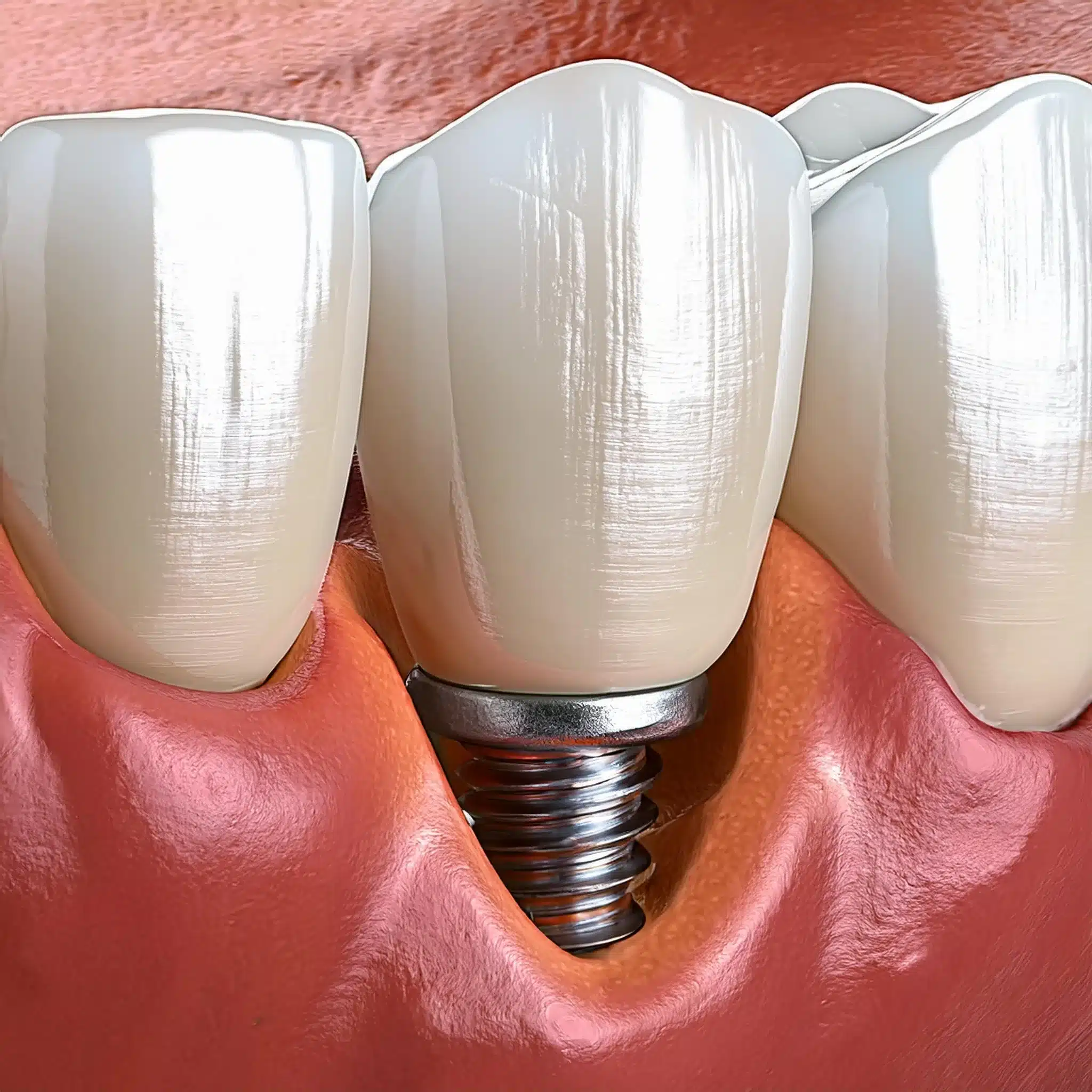
Modifikimet e stilit të jetesës
Modifikimet e stilit të jetesës, të tilla si lënia e duhanit dhe menaxhimi i kushteve shëndetësore sistemike si diabeti, mund të zvogëlojnë rrezikun e peri-implantitit.
Këto modifikime mund të përmirësojnë shëndetin e përgjithshëm dhe të zvogëlojnë komplikimet me implantet dentare (3).
Mirëmbajtje Profesionale
Mirëmbajtja profesionale, duke përfshirë pastrimin dhe pastrimin e rregullt, është e rëndësishme për të parandaluar peri-implantitin.
Kjo do të heqë biofilmat bakteriale dhe do të reduktojë inflamacionin për të ruajtur shëndetin e implantit dhe indeve përreth (4).

Përfundim & Çështje kryesore
Çelës-Takeaways
Peri-implantiti është i parandalueshëm dhe i trajtueshëm me zbulimin dhe trajtimin e hershëm.
Higjiena e mirë orale dhe kontrollet e rregullta dentare janë çelësi për parandalimin e peri-implantitit.
Njihni shkaqet, simptomat dhe trajtimin e peri-implantitit nëse keni implante dentare.
konkluzioni
Peri-implantiti është një kërcënim i madh për implantet dentare, por me kujdesin e duhur dhe ndërhyrjen e hershme, ai mund të menaxhohet.
Duke bërë kontrolle të rregullta dentare dhe higjienë të mirë orale, ju mund të zvogëloni rrezikun e peri-implantitit dhe të siguroni suksesin afatgjatë të implanteve tuaja dentare.
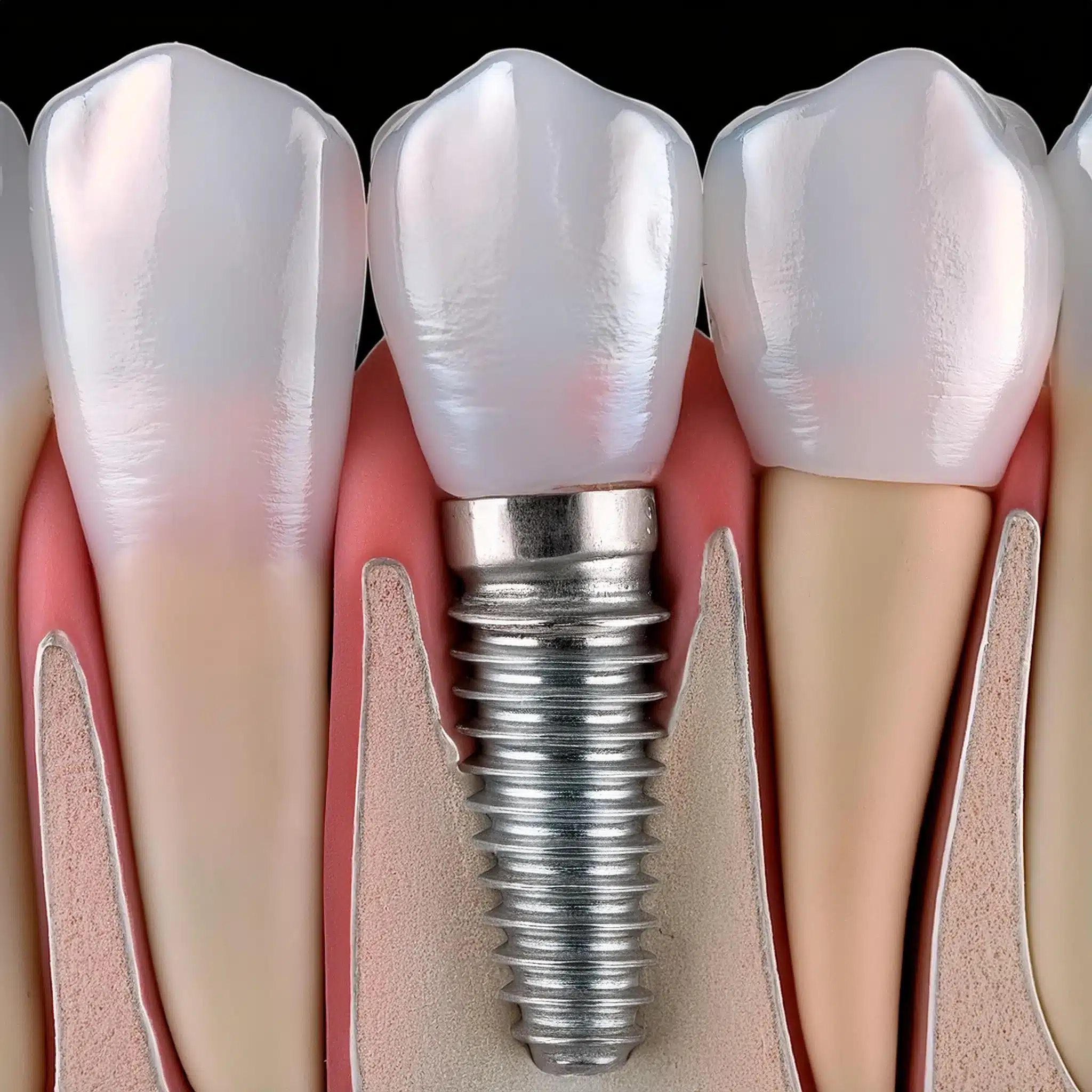
FAQ
Referencat
Renvert S, Polyzois I. Etiologjia, patogjeneza dhe trajtimi i peri-implantitit: Një konsensus evropian. J Clin Periodontol. 2024; 51: 123-130.
Neni: Etiologjia, patogjeneza dhe trajtimi i peri-implantitit: Një konsensus evropianHeitz-Mayfield LJ, Mombelli A. Peri-implantiti: fillimi i fundit për osseointegrimin? Periodontol 2000. 2014;66:251-269.
Neni: Peri-implantiti: fillimi i fundit për osseointegrimin?Schwarz F, Derks J, Monje A, Wang HL. Peri-implantiti. J Clin Periodontol. 2018; 45 (Suppl 20): S246-S266.
Neni: Peri-implantitiLindhe J, Meyle J. Sëmundjet peri-implantare: Raporti konsensus i seminarit të gjashtë evropian mbi periodontologjinë. J Clin Periodontol. 2008; 35 (Suppl 8): 282-285.
Neni: Sëmundjet peri-implantare: Raporti konsensus i Punëtorisë së Gjashtë Evropiane mbi PeriodontologjinëFiguero E, Graziani F, Sanz I, Herrera D, Sanz M. Menaxhimi i mukozitit peri-implant dhe peri-implantitit. Periodontol 2000. 2014;66:255-273.
Neni: Menaxhimi i mukozitit peri-implantar dhe peri-implantititKlinge B, Meyle J. Shkatërrimi i indeve peri-implantare. Konferenca e Tretë e Konsensusit EAO 2012. Clin Oral Implants Res. 2012; 23 (Suppl 6): 108-110.
Neni: Shkatërrimi i indeve peri-implantare. Konferenca e Tretë e Konsensusit të EAO 2012

